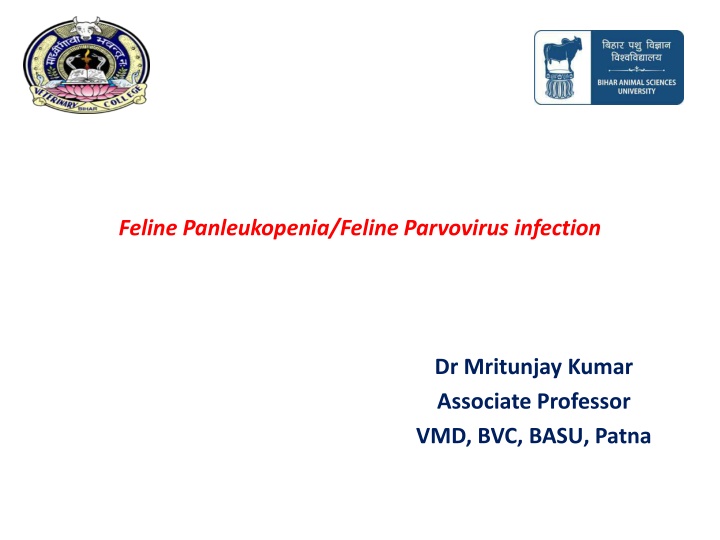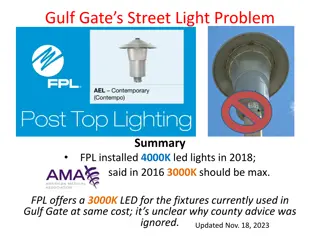
Feline Panleukopenia & Parvovirus Infection
Learn about feline panleukopenia and parvovirus infection, a contagious disease in cats caused by Feline Parvovirus. Discover its aetiology, epidemiology, transmission, pathogenesis, clinical signs, and more.
Download Presentation

Please find below an Image/Link to download the presentation.
The content on the website is provided AS IS for your information and personal use only. It may not be sold, licensed, or shared on other websites without obtaining consent from the author. If you encounter any issues during the download, it is possible that the publisher has removed the file from their server.
You are allowed to download the files provided on this website for personal or commercial use, subject to the condition that they are used lawfully. All files are the property of their respective owners.
The content on the website is provided AS IS for your information and personal use only. It may not be sold, licensed, or shared on other websites without obtaining consent from the author.
E N D
Presentation Transcript
Feline Panleukopenia/Feline Parvovirus infection Dr Mritunjay Kumar Associate Professor VMD, BVC, BASU, Patna
Feline panleukopenia is a contagious disease of cat caused by Feline Parvovirus (FPV) and characterised by depression, anorexia, high fever, vomiting, diarrhoea and severe dehydration Aetiology CPV strains (CPV-2a, 2b and 2c) may cause Feline panleukopenia in domestic cats and larger felids Virus is secreted in faeces upto 6 weeks of recovery Epidemiology Worldwide FPV can cause disease in all felids and in some members of related families (raccoon, mink) but it does not harm canids Kitten 2-6 months of age are most susceptible (once maternal immunity is lost) FPV infection is recognised as re-emerging disease in Australia Kittens are severely affected
Transmission Cats are infected oro-nasally by exposure to infected animals, their faeces, secretions or contaminated fomites FPV can be destroyed by aqueous 6% sodium hypo-chloride for 10 minutes or more at room temperature
Pathogenosis FPV infects and destroys only mitotic cells causing acute cell cytolysis of rapidly dividing cells Affected organs containing rapidly dividing cells Hemic, Lymphatic, Immune (severe panleukopenia, atrophy of thymus), GI systems (intestinal crypt cells of the jejunum and ileum) and cerebellum and retina in very young kitten Death of crypts cells- results in shortened blunt villi with poor absorption of nutrients, acute enteritis with vomiting and diarrhoea, dehydration and secondary bacteraemia Pregnant kitten- transplacental transmission cause embryonic resorption, faetal mummification, abortion and still birth Kittens in the prenatal period may destroy the germinal epithelium of the cerebellum, leading to cerebral hypoplasia, incoordination and tremor
Clinical signs Acute cases Mild to severe depression Mild to moderate elevated body temperature Typical Panleukopeniaposture -sternum and chin resting on floor, feet tucked under body and top of scapulae elevated above the back Frequent vomiting and diarrhoea Rapid and severe dehydration Abdominal pain may be elicited on palpation Retinal degeneration in kitten with neurological signs Abortion and foetal mummification in pregnant cats Ataxia from cerebral hypoplasia- signs evident at 10-14 days of age and persist for life: hypermetria, dysmetria, incoordination etc Sub-clinical or mild infection- Few or no clinical signs, mainly in adult Differential Diagnosis Salmonellosis: High TLC count, severe gastroenteritis Acute poisoning: TLC count not severely depressed, depression, sub- normal temperature
Diagnosis Based on history of age group affected and clinical signs CBC- Panleukopenia (500-3000 cells/dl in acute disease) Biochemical profile- Dehydration and electrolyte imbalance Virus isolation from faeces or affected tissues (thymus, small intestine, spleen) Chromatography test strip- Faeces for FPV and CPV CPV antigen faecal immunoassay Electron microscopy of faeces- Detects parvovirus particles, presumably FPV Treatment Principle of treatment Rehydration and establishment of electrolyte balance Supportive care until the patient immune system produces antiviral antibodies that neutralize the virus Protection against secondary bacterial infections ampicillin gentamicin combination
Vaccination Completely prevented by routine vaccination of kittens Vaccinate (Feligen CRP/Nobivac triacat @ 1 ml sc or im) kittens as early as 6-8 weeks of age, then every 3-4 weeks until 16 weeks of age Booster- Annually
Multiple choice questions Q.1. Feline parvo virus infection is also known as a) FPL b) FRT c) Feline calci virus infection d) None Q.2.Feline panleukopenia virus does not infect to a) Dog b) Raccoon c) Mink d) All of these Q.3.Typical panleukopenia posture observed in a) FPL b) FRT c) Feline calci virus infection d) None Q.4.Which of the following virus infect divining cells a) FPL b) CPV c) CDV d) a & b Q.5.FPL virus in kitten causes a) Abortion b) Cerebral hypoplasia c) Retinal degeneration d) All of these




